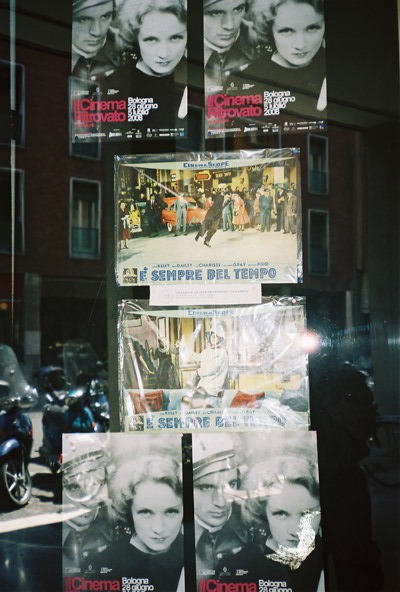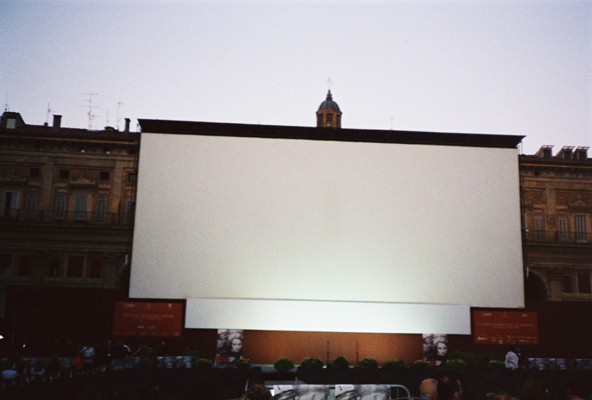Neil Watson returns to Bologna for another marathon session of vintage films at the Il Cinema Ritrovato festival
As some readers of Turntable & Blue Light may recall, my annual holiday for the past three years has revolved around the Il Cinema Ritrovato Festival, held in Bologna from 28 June–5 July. Launched 22 years ago, the festival showcases vintage films from archives around the world, painstakingly restored to produce the best quality prints. For one week, Bologna becomes a true cinema city, with screenings for 12 hours a day in the two cinemas comprising the Cineteca Bologna and in the 1960s Cinema Arlecchino, which has a curved screen for scope formats. Evenings are dominated by the outdoor screenings in the Piazza Maggiore, in front of the Basilica, with seating for 5000 people. There are numerous thematic strands to the festival – usually concentrating on a director, a star, an archive and the subfestival of films that are exactly a century old. If, like me, you are passionate about all vintage cinema, the major problem each day is deciding which films to watch or, more accurately, which to miss. The only downside of the festival is the heat – the temperature is generally between 35–40ºC, with incredible humidity.
During the week I avoid hotels, instead preferring to stay with locals, contacted via couchsurfing.com. I love the couchsurfing concept – you meet complete strangers, learn how they live and about their hopes, philosophies and aspirations. Sometimes lasting friendships can result, which is truly wonderful.
I started this year’s adventure by staying with Julie and Matteo, who live out in the countryside in San Pietro in Casale, with their assorted cats and dogs. They were my final hosts at the end of last year’s festival; we had stayed in contact through Facebook and they had invited me back. When we met on Friday night, Matteo was on the way to his multi-cultural choir, which rehearses in the university hall of residence. I used to sing in a choir myself, so I joined in with Mozart’s Ave Verum Corpus; the lament for the Partisans, dating from World War II; a lively Yiddish song and a cheery little Italian number about sharing love underneath an umbrella. Matteo was very kind about picking me up after the evening screenings in the Piazza and even came to see one film with me.
My next host, Tamara, was located on the outskirts of Bologna. As she was a nurse, I didn’t see much of her, but I enjoyed sharing the couch with her very sweet two-month-old kitten! The final host was Andrea, a law student staying in the centre of Bologna. He was extremely hospitable, giving up his bed for me and taking me out for numerous nights on the town, including a disco in a courtyard and introducing me to a liqueur called Limoncello. Through couchsurfing, I also met up with Sonia, who shared my love of silent cinema and Pietro, a jazz musician who invited me to a big band concert in a nearby village. This took place in a home for mentally disabled people, and I don’t think I will ever forget seeing the patients dancing in their wheelchairs, assisted by their carers, proving the therapeutic power of music.
Now to the films. This time I saw 44 films during the week, but here are five, indicating the scope of this wonderful festival:
"La Bandera" (Julien Duvivier; France; 1935)
This was the film that really kicked off Jean Gabin’s career and effectively marked the inception of the Poetic Realism movement, which dominated French cinema in the mid to late 1930s. Beginning with a remarkable crane shot that travels down to a grisly murder in the rue St. Vincent, Paris, Gabin is a hunted man. He joins the Spanish foreign legion and ends up in French Morocco. But his past catches up with him, and a fellow legionnaire tries to claim the bounty on his head. The Fascist General Franco permitted location filming, and the film is most amazing for its authenticity. The chase scene in Barcelona was filmed ‘wild’ (without sound) with a handheld hidden camera; canted camera angles were used during the fight scenes and the ending, in a hot fortress surrounded by natives was unforgettable. I particularly enjoyed the performance by Annabella as the Bedouin girl who captures Gabin’s heart with her singing and dancing. The wedding sequence, involving tattooing and blood-letting, has to be seen to be believed!
"Blonde Venus" (Josef von Sternberg; USA; 1932)
Von Sternberg’s films were a major theme at this year’s festival, both with and without his muse, Marlene Dietrich. Blonde Venus remains my favourite of the films they made together – starting with a censor-baiting sequence where Dietrich is skinny-dipping in a lake in the Bavarian forest with her friends and is spied on by American nuclear scientist Herbert Marshall. The film is most unusual for its shifting tone – Dietrich is portrayed as a loving wife and mother, who returns to work as a showgirl to earn the money to cure her husband of radium poisoning, yet is pursued by and falls in love with impresario Cary Grant. Most famous for the Hot Voodoo number, in which Dietrich is dressed in a gorilla suit, the sequences on the run in the southern states of the USA was most gripping and the section where her unforgiving husband seizes her child showed the full range of Dietrich’s acting skills.
Piazza Maggiore
"Susuz Yaz" (Dry Summer) (Metin Erksan; Turkey; 1964)
Despite its comparative youth, this was very nearly a ‘lost’ film. After winning the Golden Bear at Berlin in 1964, the film vanished without trace as the Turkish authorities objected to it representing their country as a brutal, rural, subsistence economy. Last year, the producer was contacted by the Cineteca Bologna, who wished to restore the film. He brought the original negative out of a vault, only to discover that the final reel was missing. It was extremely fortunate that a copy had been retained in Berlin which could supply the missing footage.
For me, this was the most impressive film of the festival. Shot on location in an extremely rural part of Turkey, the film tells the story of a truly evil man, Oman, who decides to divert the local water supply to irrigate his own land. He kills a man who tries to destroy his dam and lets his own brother take the blame. Oman then tries to steal Bahar, his brother’s wife, even telling her that her husband has died in jail. However, there is a general amnesty, his brother is set free and he comes back seeking revenge. Oman is eventually killed; his body being washed away in the water as his dam is destroyed.
This was a very atmospheric film, shot entirely on location. The heat of the sun genuinely radiated out of the film; the women all wore elaborated Muslim headscarves and there was much use of handheld cameras. The music, played on the oud, added much to the experience.
"Dura Lex" (By the Law) (Lev Kuleshov; USSR; 1926)
Kuleshov was the pioneer of Soviet montage and its psychological effects and his work was a major theme at this year’s festival. Shown in the Piazza Maggiore, this was based on a Jack London story, being set in the Yukon. It told the story of a prospector, driven mad by greed, who kills two of his five colleagues. The survivors – a husband and wife – must decide whether to enact capital punishment or wait until they reach civilisation. The small wooden hut in which they live is then flooded, which further delays matters.
Made during a time when the state film agency, Goskino, forced a reduction in production costs, resulting in the use of single set, this was still most effective at creating a sense of claustrophobia. The struggle of the condemned man to gain freedom, both via psychological and physical methods was most effective, and I don’t think I will ever forget the sequence when he returns following execution with a noose around his neck.
"Blackmail" (Alfred Hitchcock; UK; 1929)
Seemingly the entire population of Bologna descended on the Piazza Maggiore to see the silent version of Hitchcock’s Blackmail, with a witty new orchestral score by Neil Brand. In fact, Blackmail remains best-known as the first British sound film, and for many years that is the way it was seen, both at the cinema and on television. However, it was actually completed as a silent film, the sound version being produced by Hitchcock at the behest of British International Pictures. However, the sound version is only about 75 per cent sound – the first two reels are just silent with music and sound effects.
However, Hitchcock always maintained that the silent version was superior and I am inclined to agree with him. The silent version contains more shots, more fluid editing and there is greater camera movement. The story is quite a simple – a young girl (Anny Ondra) is lured into an attic by an artist, who attempts rape and she stabs with a breadknife. Her boyfriend is a police officer who is brought on the case and he is blackmailed. There are numerous famous sequences, particularly when Anny Ondra walks around Trafalgar Square at dawn after committing the murder and the concluding chase across the roof of the British Museum Reading Room, culminating in the blackmailer falling to his death.
I had a wonderful time at this year’s festival, and look forward to the 2009 event!
- Neil Watson
Neil Watson lives in London and is a regular contributor and film aficionado extraordinaire for Turntable & Blue Light.







